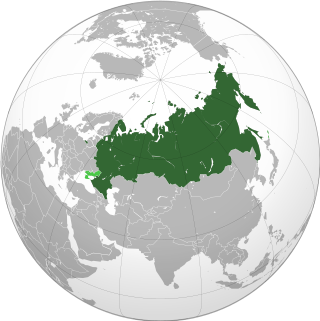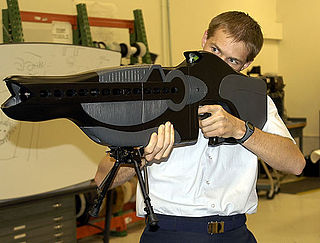Related Research Articles

The Environmental Modification Convention (ENMOD), formally the Convention on the Prohibition of Military or Any Other Hostile Use of Environmental Modification Techniques, is an international treaty prohibiting the military or other hostile use of environmental modification techniques having widespread, long-lasting or severe effects. It opened for signature on 18 May 1977 in Geneva and entered into force on 5 October 1978.
Arms control is a term for international restrictions upon the development, production, stockpiling, proliferation and usage of small arms, conventional weapons, and weapons of mass destruction. Historically, arms control may apply to melee weapons before the invention of firearm. Arms control is typically exercised through the use of diplomacy which seeks to impose such limitations upon consenting participants through international treaties and agreements, although it may also comprise efforts by a nation or group of nations to enforce limitations upon a non-consenting country.
The Protocol for the Prohibition of the Use in War of Asphyxiating, Poisonous or other Gases, and of Bacteriological Methods of Warfare, usually called the Geneva Protocol, is a treaty prohibiting the use of chemical and biological weapons in international armed conflicts. It was signed at Geneva on 17 June 1925 and entered into force on 8 February 1928. It was registered in League of Nations Treaty Series on 7 September 1929. The Geneva Protocol is a protocol to the Convention for the Supervision of the International Trade in Arms and Ammunition and in Implements of War signed on the same date, and followed the Hague Conventions of 1899 and 1907.

A weapon of mass destruction (WMD) is a biological, chemical, radiological, nuclear, or any other weapon that can kill or significantly harm many people or cause great damage to artificial structures, natural structures, or the biosphere. The scope and usage of the term has evolved and been disputed, often signifying more politically than technically. Originally coined in reference to aerial bombing with chemical explosives during World War II, it has later come to refer to large-scale weaponry of warfare-related technologies, such as biological, chemical, radiological, or nuclear warfare.

The law of war is the component of international law that regulates the conditions for initiating war and the conduct of hostilities. Laws of war define sovereignty and nationhood, states and territories, occupation, and other critical terms of law.

Non-lethal weapons, also called nonlethal weapons, less-lethal weapons, less-than-lethal weapons, non-deadly weapons, compliance weapons, or pain-inducing weapons are weapons intended to be less likely to kill a living target than conventional weapons such as knives and firearms with live ammunition. It is often understood that unintended or incidental casualties are risked wherever force is applied, but non-lethal weapons try to minimise the risk of casualties as much as possible. Non-lethal weapons are used in policing and combat situations to limit the escalation of conflict where employment of lethal force is prohibited or undesirable, where rules of engagement require minimum casualties, or where policy restricts the use of conventional force. However, these weapons occasionally cause serious injuries or death due to allergic reactions, improper use and/or other factors; for this reason the term "less-lethal" has been preferred by some organizations as it describes the risks of death more accurately than the term "non-lethal", which some have argued is a misnomer.

The Biological Weapons Convention (BWC), or Biological and Toxin Weapons Convention (BTWC), is a disarmament treaty that effectively bans biological and toxin weapons by prohibiting their development, production, acquisition, transfer, stockpiling and use. The treaty's full name is the Convention on the Prohibition of the Development, Production and Stockpiling of Bacteriological (Biological) and Toxin Weapons and on their Destruction.

A directed-energy weapon (DEW) is a ranged weapon that damages its target with highly focused energy without a solid projectile, including lasers, microwaves, particle beams, and sound beams. Potential applications of this technology include weapons that target personnel, missiles, vehicles, and optical devices.

The Russian Federation is known to possess or have possessed three types of weapons of mass destruction: nuclear weapons, biological weapons, and chemical weapons. It is one of the five nuclear-weapon states recognized under the Treaty on the Non-Proliferation of Nuclear Weapons. Russia possesses a total of 5,889 nuclear warheads as of 2023, the largest confirmed stockpile of nuclear warheads in the world. Russia's deployed missiles number about 1,674, also the largest confirmed strategically deployed arsenal in the world as of 2023. The remaining weapons are either in reserve stockpiles, or have been retired and are slated for dismantling. Russia's predecessor state, the Soviet Union, reached a peak stockpile of about 45,000 nuclear warheads in 1986. The number of weapons Russia may possess is currently controlled by the bilateral New START treaty with the United States.

Biological weapons are pathogens used as weapons. In addition to these living or replicating pathogens, toxins and biotoxins are also included among the bio-agents. More than 1,200 different kinds of potentially weaponizable bio-agents have been described and studied to date.

The United Nations Convention on Certain Conventional Weapons, concluded at Geneva on October 10, 1980, and entered into force in December 1983, seeks to prohibit or restrict the use of certain conventional weapons which are considered excessively injurious or whose effects are indiscriminate. The full title is Convention on Prohibitions or Restrictions on the Use of Certain Conventional Weapons Which May Be Deemed to Be Excessively Injurious or to Have Indiscriminate Effects. The convention covers land mines, booby traps, incendiary devices, blinding laser weapons and clearance of explosive remnants of war.

The personnel halting and stimulation response rifle (PHASR) is a prototype non-lethal laser dazzler developed by the Air Force Research Laboratory's Directed Energy Directorate, U.S. Department of Defense. Its purpose is to temporarily disorient and blind a target. Blinding laser weapons have been tested in the past, but were banned under the 1995 UN Protocol on Blinding Laser Weapons, which the United States acceded to on 21 January 2009. The PHASR rifle, a low-intensity laser, is not prohibited under this regulation, as the blinding effect is intended to be temporary. It also uses a two-wavelength laser. The PHASR was tested at Kirtland Air Force Base, part of the Air Force Research Laboratory Directed Energy Directorate in New Mexico.

A dazzler is a non-lethal weapon which uses intense directed radiation to temporarily disorient its target with flash blindness. They can effectively deter further advances, regardless of language or cultural barriers, but can also be used for hailing and warning. Targets can include electronic sensors as well as human vision.

A laser weapon is a type of directed-energy weapon that uses lasers to inflict damage. Despite decades of research and development, as of 2023, directed-energy weapons, including lasers, remain at the experimental stage. Whether they will be deployed as practical, high-performance military weapons remains to be seen. One of the major issues with laser weapons is atmospheric thermal blooming, which is still largely unsolved. This issue is exacerbated when there is fog, smoke, dust, rain, snow, smog, foam, or purposely dispersed obscurant chemicals present. In essence, a laser generates a beam of light that requires clear air or a vacuum to operate.
The Protocol on Blinding Laser Weapons, Protocol IV of the 1980 Convention on Certain Conventional Weapons, was issued by the United Nations on 13 October 1995. It came into force on 30 July 1998. As of the end of April 2018, the protocol had been agreed to by 109 nations.

War can heavily damage the environment, and warring countries often place operational requirements ahead of environmental concerns for the duration of the war. Some international law is designed to limit this environmental harm.
A tectonic weapon is a hypothetical device or system which could trigger earthquakes, volcanic eruptions, or other seismic events in specified locations by interfering with the Earth's natural geological processes. It was defined in 1992 by Aleksey Vsevolodovich Nikolayev, corresponding member of the Russian Academy of Sciences: "A tectonic or seismic weapon would be the use of the accumulated tectonic energy of the Earth's deeper layers to induce a destructive earthquake". He added "to set oneself the objective of inducing an earthquake is extremely doubtful." Though no such device is known to have been built, tectonic weapons have occasionally appeared as plot devices in works of fiction.
United Nations General Assembly Resolution 31/72 referred the Environmental Modification Convention (ENMOD) “to all States for their consideration, signature, and ratification”. The resolution was adopted on 10 December 1976 at the 31st Session of the UN General Assembly. The convention aims to prohibit the military or other hostile use of environmental modification techniques that have widespread, long-lasting, or severe effects. The convention entered into force on 5 October 1978.
References
- ↑ A.N. Terschenko; I.V. Ovcharenko; O.D. Yalnickii; V.N. Kuprii. "Main Directions of Development of Weapons on New Physical Principles, Science and Technology of the Ukrainian Air Force". Ivan Kozhedub Kharkiv National Air Force University (in Ukrainian). Retrieved January 8, 2017.
- ↑ "Оружие на новых физических принципах (New Physical Principles Weapons)". Ministry of Defense of the Russian Federation? Encyclopedia (in Russian) (in Russian). Retrieved January 7, 2017. This tertiary source reuses information from other sources but does not name them.
- 1 2 Department of Political and Security Council Affairs, United Nations Centre of Disarmament. "The United Nations Disarmament Yearbook: Volume 02: 1977" (PDF). United Nations Disarmament Organization. pp. 41, 344. Retrieved January 8, 2017.
- 1 2 "Telegram 4005 From the Mission to the United Nations to the Department of State - UNGA Disarmament: Soviet Memorandum on Disarmament". United States Department of State. September 29, 1976. Retrieved January 7, 2017.
- 1 2 "Convention on the prohibition of military or any other hostile use of environmental modification techniques (with annex). Adopted by the General Assembly of the United Nations on 10 December 1976" (PDF). United Nations. December 20, 1976. p. 3. Retrieved January 7, 2017.
- 1 2 NATO News. "Non-lethal weapons: new technologies to preserve lives". North Atlantic Treaty Organization. Retrieved January 7, 2017.
- ↑ "Developing Non-Lethal Weapons". United States Department of Defense. Retrieved January 7, 2017.
- ↑ "Current Non-Lethal Weapons". United States Department of Defense. Retrieved January 7, 2017.
- ↑ "Future Non-Lethal Weapons". United States Department of Defense. Retrieved January 7, 2017.
- ↑ "Convention on the prohibition of military or any other hostile use of environmental modification techniques (with annex). Adopted by the General Assembly of the United Nations on 10 December 1976" (PDF). United Nations. December 20, 1976. Retrieved January 7, 2017.
- ↑ "Final Document of the Seventh Review Conference" (PDF). BWC/CONF.VII/7. United Nations. 13 January 2012. Retrieved 28 February 2016.
- ↑ "2 .a Additional Protocol to the Convention on Prohibitions or Restrictions on the Use of Certain Conventional Weapons which may be deemed to be Excessively Injurious or to have Indiscriminate Effects (Protocol IV, entitled Protocol on Blinding Laser Weapons)". United Nations Treaty Collection. April 7, 2014. Retrieved July 4, 2014.
- ↑ The Russian Federation. "Военная доктрина Российской Федерации (Military Doctrine of the Russian Federation)" (PDF). Kremlin (in Russian). Retrieved January 7, 2017.
- ↑ "Владимир Путин: "Быть сильными: гарантии национальной безопасности для России" (Vladimir Putin: "Be strong: National security guarantees for Russia")". RG. February 20, 2012. Retrieved January 7, 2017.
- ↑ "Путин: в России идут разработки оружия на основе новых физических принципов (Putin: Russia's are developing weapons based on new physical principles)". Regnum (in Russian). November 18, 2016. Retrieved January 7, 2017.
- ↑ "В России создано уникальное радиоэлектронное оружие (In Russia, created a unique radio-electronic weapons)". Comments of Ukraïnski News (in Russian). October 14, 2016. Retrieved January 7, 2017.
- ↑ https://www.armyrecognition.com/weapons_defence_industry_military_technology_uk/russian_peresvet_laser_weapon_can_blind_satellites_at_1500_km_altitude.html
- ↑ https://www.showmetech.com.br/en/russia-gives-details-about-lethal-weapon-that-causes-hallucination-and-confuses-vision/
- ↑ https://www.thedefensepost.com/2021/08/26/russia-visual-optical-blinding-weapon/